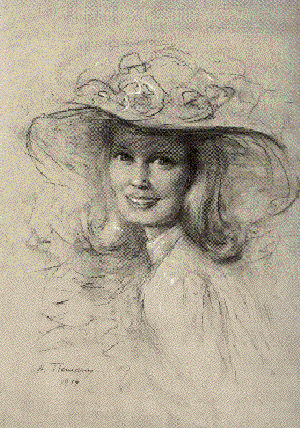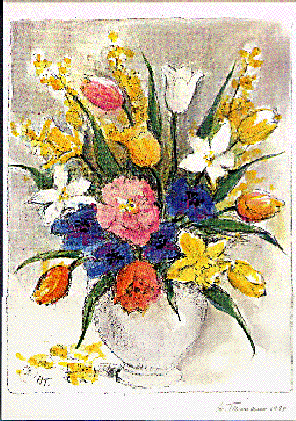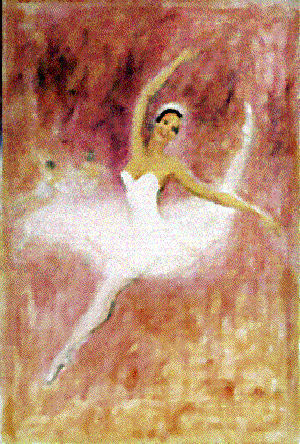
HELGA TIEMANN - THE FIRST LADY OF PAINTING
By B. John Zavrel

HELGA TIEMANN - THE FIRST LADY OF PAINTING
By B. John Zavrel
Born in one of the most romantic areas of Europe, in the German town of Remscheid on the Rhine River, Helga Tiemann has gained international reputation as one of the significant portraitists of our the second half of the 20th century.
Helga Tiemann has lived, studied, and worked since early childhood in Köln. Her initial study of the arts took place here, and later continued at the University for the Fine Arts in Berlin. She studied with Professors Spiegel and Eichhorst. Already at this young age, she showed an extraordinary talent, and as a "master student" was invited to have her works shown at public art exhibitions in Berlin, Munich, and Salzburg.
Some years ago, I was privileged to visit Helga Tiemann in her studio in Köln. On this occasion I had not only a chance to see a number of her paintings, but also I had the rare opportunity to view the large collection of photographs of paintings, covering the last 50 years of her creative work. I was impressed that already in her young days as an artist she attained a mature, noble style in all of her paintings.
Irene Von Verfeldt
Portraits of women, such as LYDIANNE BAUM or IRENE VON ELVERFELDT radiate beauty, grace, nobility, and inner harmony of her models. Helga Tiemann is one of those rare artists, who see the good and beautiful in mankind. It is no wonder that her reputation as a portraitist has spread into the rest of Europe, Great Britain, and America.
In 1953 Helga Tiemann was invited by Konrad Adenauer, the first Chancellor of the Federal Republic of Germany, to paint his portrait in his official residence, the Schaumburg Palace. Since then, she was commissioned again and again to do portraits of university rectors and government ministers, foreign statesmen like Ronald Reagan, Richard von Weizsäcker, Margaret Thatcher, Henry Kissinger, Queen Elisabeth, the sculptor Arno Breker, Tilla Durieux, Katia Mann, the wife of Thomas Mann, and many others.
 But her work is not limited only to portraits of the famous and beautiful. Helga Tiemann's colorful and cheerful paintings of flowers, expressive drawings of animals, especially horses, as well as paintings of nature show the many facets of the richness of her artistic expression.
But her work is not limited only to portraits of the famous and beautiful. Helga Tiemann's colorful and cheerful paintings of flowers, expressive drawings of animals, especially horses, as well as paintings of nature show the many facets of the richness of her artistic expression.
Helga Tiemann's works have been shown at numerous exhibitions in Germany and abroad. At one of her early exhibitions in 1962, in the International Club Redute in Bad Godesberg, her large wall painting HISTORIC RHINELAND was included in the collection of her works. The painting created such an impression, that after the exhibition someone cut it out of its frame and the painting has not been seen ever since.
Further exhibitions followed in Germany and abroad: in Berlin, Köln, Munich, Salzburg, Paris, Hamburg, at the Nörvenich Castle near Bonn, at the Prague Castle Hradcin, in Moscow.
 A very unique exhibition of Helga Tiemann's works took place in Bonn in 1987. The exhibition of portraits of prominent politicians of our time was sponsored by the German Parliament and also included a number of bronze busts by the sculptor Kurt Arentz. At this exhibition, Konrad Adenauer met the Queen Elisabeth, Ronald Reagan faces at Mildred Scheel as the conductor Herbert von Karajan looks on.
A very unique exhibition of Helga Tiemann's works took place in Bonn in 1987. The exhibition of portraits of prominent politicians of our time was sponsored by the German Parliament and also included a number of bronze busts by the sculptor Kurt Arentz. At this exhibition, Konrad Adenauer met the Queen Elisabeth, Ronald Reagan faces at Mildred Scheel as the conductor Herbert von Karajan looks on.
In 1993, the U.S. Museum of European Art in Clarence, New York, has acquired for its collection Helga Tiemann's cyclus THE FOURS SEASONS, paintings of flowers representing the four faces of Nature in spring, summer, fall, and winter. Later, to these works a number of lithographs were added to give a deeper insight into her creative work.